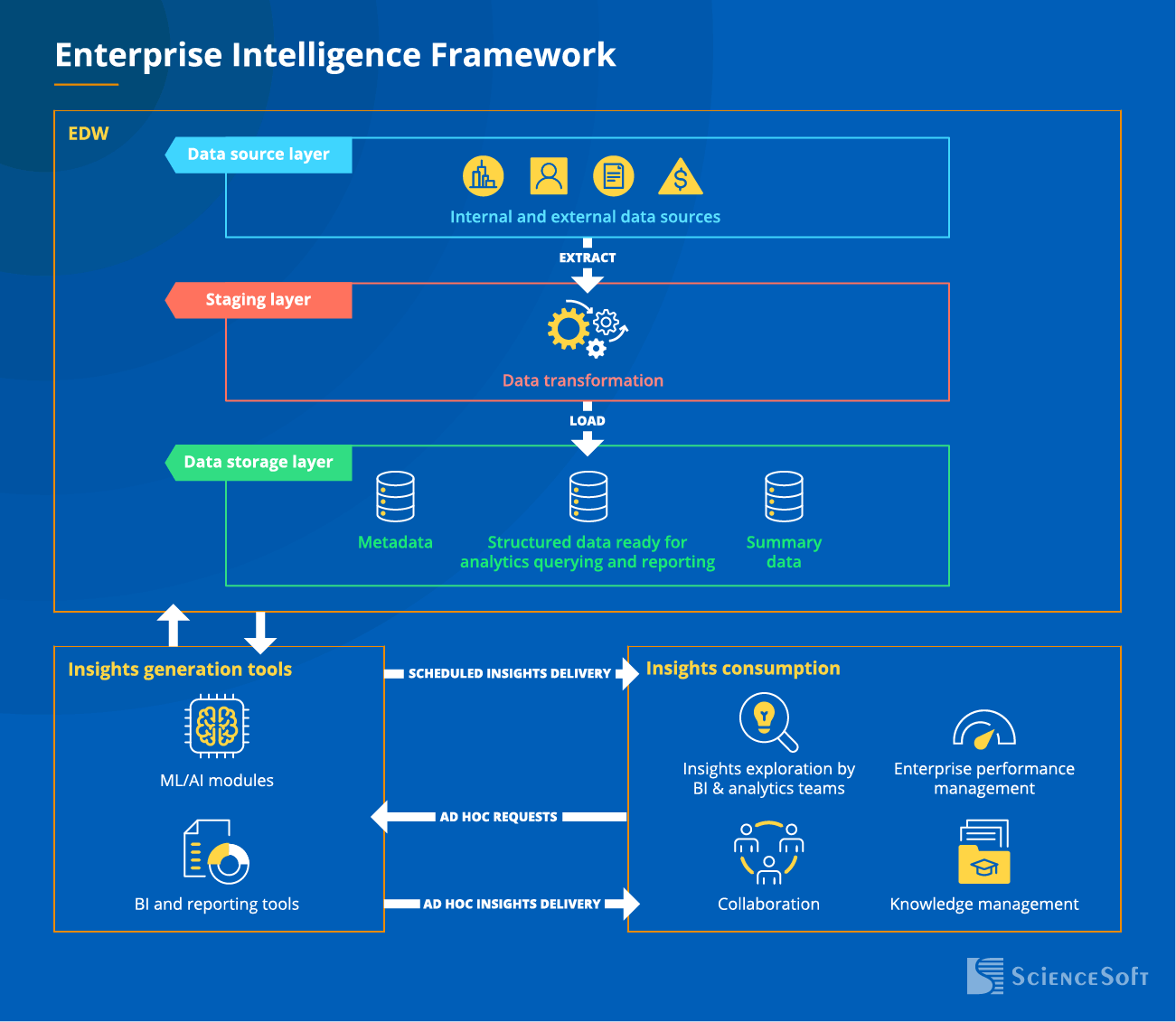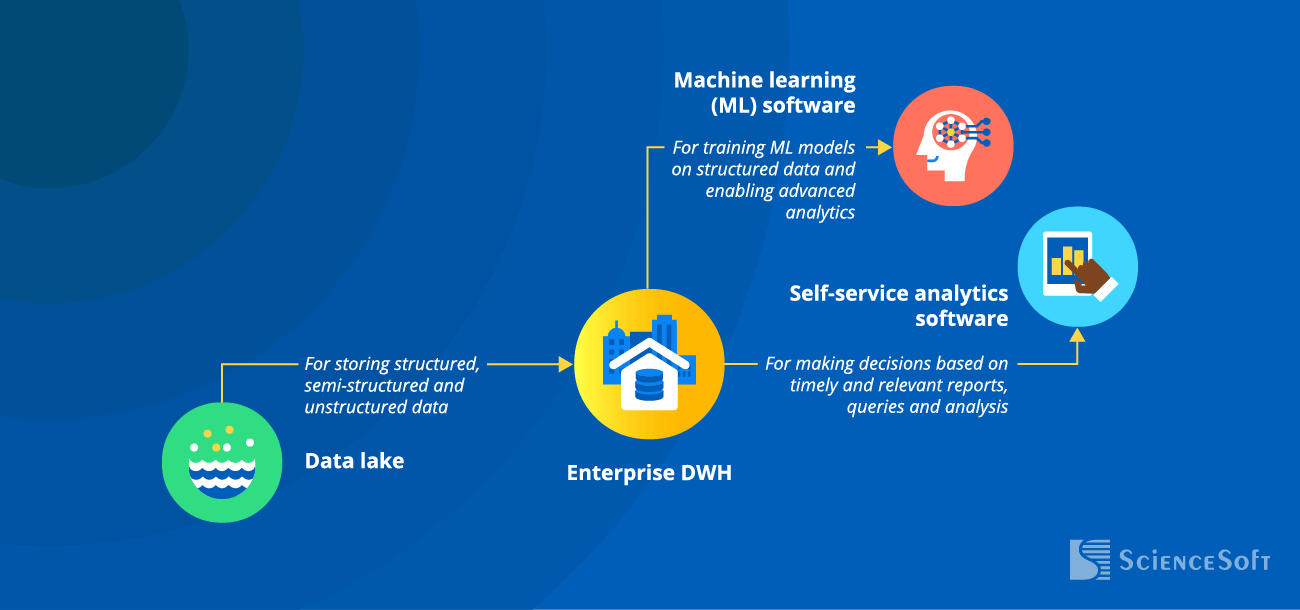Enterprise Data Warehouse
Architecture, Features, Integrations, Costs
Since 2005, ScienceSoft has been providing businesses from 30+ industries with scalable EDW solutions for efficient data consolidation and enterprise-wide analytics.
What Is an Enterprise Data Warehouse: Core Concepts
An enterprise data warehouse (EDW) is a data management solution that centralizes company-wide data in a highly structured format ready for analytics querying and reporting.
- Possible integrations: a data lake, ML and BI software.
- Implementation timeline: 3-12 months.
- Implementation costs: $70,000 – $1,000,000, depending on solution complexity. Use our online calculator to estimate the cost for your case.
- ROI: up to 400% five-year ROI with the investment usually breaking even within 9 months.
To enable answering both enterprise-level and team-specific questions, EDW ingests data from all corporate business-critical software and external data sources, including:
|
|
EDW as Part of Revenue-Driving Enterprise Intelligence Framework
Enterprise intelligence is the ability of a business to synthesize information, deliver insights at scale, learn from them collectively, and develop a strong data culture. IDC reports that businesses with excellent enterprise intelligence index achieve a 10% increase in revenue growth and customer acquisition rates and enjoy shorter time to market for new offerings.
Below, our experts share a high-level EDW architecture and show the EDW’s core place within the enterprise intelligence framework.

- Information synthesis: an EDW pulls data from multiple sources, cleans, aggregates or otherwise transforms it, and loads analytics-ready data to the data storage.
- Insights delivery at scale: an EDW feeds BI and ML/AI analytics tools with accurate, up-to-date data. EDW’s highly structured nature allows for both scheduled reporting and ad hoc data exploration, which ensures flexibility in insights delivery.
- Collective learning: being a single point of truth, an EDW guarantees that all users make decisions based on common information and remain on the same page regarding current processes and past experiences.
- Strong data culture: An EDW is essential for eliminating manual work and providing value-driving insights. It helps build an environment where employees value data, trust it, and prioritize data-driven decision making.
Enterprise Data Warehouse Types
There are three deployment environment types for data warehousing solutions:
- On-premises – a company purchases all required hardware and software to build and deploy an EDW and maintains it further on.
- Cloud-hosted – a company deploys an EDW in the cloud, eliminating the need to purchase and maintain hardware and software.
- Hybrid – a company augments an on-premises enterprise data warehouse with a cloud-hosted repository.
On-premises
Pros:
- Full control over the enterprise data warehouse. In case of a failure, an in-house IT team has direct access to the DWH’s problem area for hardware and software tuning. Moreover, data security remains strictly under the in-house IT team’s control.
- Full compliance with the required data standards. Data security compliance is easier to achieve with on-premises enterprise DWHs.
- Availability. Business users from a facility where the EDW is located can effectively access all the data stored in the data warehouse without dependence on the internet connection.
See the points of caution
Cloud
Pros:
- Scalability. The inherent agility of cloud data warehouses allows upscaling and downscaling with no impact on enterprise data warehouse performance.
- Reduced costs. There are no hardware-related costs (hardware acquisition, deployment, maintenance, administration, etc.). And if you opt for Enterprise Data Warehouse as a Service, all software acquisition and maintenance costs are eliminated too.
See the points of caution
Hybrid
Pros:
- Cloud flexibility. Meeting storage and compute requirements with near-unlimited cloud resources.
- Data compliance. Ensuring sensitive data is stored within the environment which fully meets data compliance standards.
See the points of caution
Enterprise Data Warehouse Key Features
With experience in 30+ domains, ScienceSoft delivers DWH solutions tailored to specific industry needs and unique business goals of our clients. From our experience, the following features of an enterprise data warehouse make up a secure and efficient solution.
- Creating enterprise data warehouse models.
- Data integration with ETL/ELT.
- Full and incremental data extraction/load.
- Structured, semi-structured, unstructured data ingestion.
- Big data ingestion.
- Streaming data ingestion.
- Data loading and querying using SQL.
- Subject-oriented data repository.
- Time-variant (data from the historical point of view) data repository.
- Nonvolatile (read-only) data repository.
- Granular data storage.
- Metadata storage.
- Storage in multiple environments (cloud, on-premises, hybrid).
Database performance
- Scalability.
- Automated DWH maintenance tasks – backups, replication, patching, etc.
- Advanced data searching (materialized view support, data indexes, result-caching, etc.).
To build a future-proof EDW with all the necessary features, it’s crucial to create data models that not only reflect current business operations but can be easily modified in response to your business growth. Keeping data models’ flexibility in mind, ScienceSoft’s solution architects always work together with seasoned industry experts to envisage potential business changes and efficiently organize enterprise data access, collection, storage, analysis, security, etc.
Key EDW Integrations

Ensures cost-efficient storage of raw data in its initial format. We often implement tiered raw data storage for further cost optimization, e.g., keeping frequently accessed data in a high-performing, costlier tier and storing less ‘popular’ data in a lower-cost, lower-performance tier.
Self-service analytics software
Your team members can generate the reports they need within minutes instead of waiting days for IT or data analysts to create them. Having access to accurate and up-to-date data at the required angle, they can make informed decisions.
Machine learning software
Your data scientists get access to vast amounts of reliable data to build highly accurate models for forecasts, process automation, smart recommendations, and more.
I believe one of the reasons ScienceSoft has many satisfied customers is our focus on trying to see a bigger picture rather than solving discrete tasks. We don’t consider an EDW as a stand-alone component. Instead, we plan and implement integrations that will help our clients improve the work of their teams and connect the dots among disparate business processes, different technologies, and cross-team initiatives. Such an approach takes effort, including writing custom code and building APIs. However, the result is always worthwhile, as it has a decades-long positive impact on business growth and profitability.
Development Costs and Timelines
The cost of enterprise data warehouse development may vary from $70,000 to $1,000,000+*, depending on software complexity.
$70,000 – $200,000
For a simple solution with up to 5 data sources, basic data management, and rule-based analytics of structured data.
$200,000 – $400,000
For a medium complexity solution that encompasses up to 15 data sources, features advanced data management and real-time analytics. It enables both rule-based and ML powered insights driven from all types of data.
$400,000 – $1,000,000
For an advanced, maximally automated solution that supports real-time analytics (incl. big data) and ML/AI-powered scenario modeling across all the integrated data sources.
*Monthly software license fee and other regular fees are NOT included.
Based on ScienceSoft’s experience in EDW software implementation, the approximate timeframes for an EDW implementation project are from 3 to 12 months, and the cost of an enterprise data warehouse implementation project may vary as follows:
Ballpark timelines for each stage of EDW implementation
A typical ScienceSoft's project on EDW software implementation covers the following stages and timelines:
- EDW goals elicitation: 3-20 days.
- EDW solution conceptualization and tech stack selection: 2-15 days.
- Business case and project roadmap creation: 2-15 days.
- System analysis and EDW architecture design: from 15 days.
- EDW solution development and stabilization: from 2 months.
- EDW solution launch: from 2 days.
- After-launch support, maintenance, and evolution: as requested.
Hide
Enterprise Data Warehouse Benefits
Looking for Professional EDW Services?
We have been developing enterprise data warehouse solutions since 2005. Our team of data analytics professionals with 12–27 years of experience and in-house compliance experts ensures your EDW is future-proof, high-performing, scalable, and secure. Having established project management practices, we drive projects to their goals regardless of time and budget constraints and changing requirements.
Solutions ScienceSoft Recommends
The selected platforms are recognized leaders in enterprise data warehousing solutions (The Forrester Wave, Gartner’s 2025 evaluation of cloud databases for analytics), which are fully compliant with the key criteria for an enterprise-scale DWH: almost instant scalability of compute and storage resources (due to the cloud-based nature), high performance and availability (up to 99.99% uptime), advanced security, etc.
Azure Synapse Analytics
Description
A scalable analytics platform that combines dedicated data-warehouse (Dedicated SQL pools) and serverless query options, Spark pools, and direct access to data in Azure Data Lake — enabling relational and lake-style analytics from one service.
Pricing
Data storage - $23 per TB/month ($0.04/1 TB/hour). The data storage encompasses the size of your DWH and 7 days of incremental snapshot storage.
Learn Azure Synapse costs for your case with Pricing Calculator
Data security
Built-in capabilities include encryption at rest and in transit, role-based access (Azure RBAC), row/column-level protection and dynamic data masking (for dedicated pools), and options to integrate with Azure Defender / Microsoft Defender for Cloud for threat detection. Some features differ between dedicated and serverless modes (e.g., DDM is for dedicated pools).
Best for
Best when you want tight integration with the Azure ecosystem, need both serverless exploration and provisioned DW performance, or plan heavy integration with Spark and Synapse pipelines. If you expect persistent, predictable heavy compute, reserved DWU capacity often saves money.

Amazon Redshift
Description
AWS’s cloud data warehouse with provisioned clusters (node types) and Redshift Serverless. RA3 nodes decouple compute from managed storage so you can scale compute and storage independently. Redshift Spectrum lets you query S3 data in-place.
Pricing
The price is charged according to the amount of stored data and the number of nodes. The on-demand pricing option starts from $0.25/hour (hourly rate based on the type and number of nodes in the cluster).
Learn Amazon Redshift costs for your case with Pricing Calculator.
Data security
Redshift supports end-to-end encryption (in transit via TLS, at rest via AES), VPC isolation, IAM/roles, integration with Secrets Manager and KMS, and fine-grained access controls. AWS has been tightening defaults (e.g., encryption and disabling public access by default for new clusters).
Best for
Good fit for AWS-first shops, when you want fine control over instance/node sizing or want predictable per-node performance. RA3 + managed storage is attractive when you need to grow storage independently of compute.
Google BigQuery
Description
A serverless, highly scalable analytical data warehouse built on Dremel-style architecture. It separates storage and compute (on-demand or capacity/flat-rate), and is optimized for instant ad-hoc queries on massive datasets.
Pricing
Storage costs: $0.02/GB/mo ($0.01/GB/month for long-term storage).
Streaming inserts: $0.01/200 MB.
For query performance, 2 subscription options are available:
- Pay-as-you-go ($5/TB, 1st TB/month is free).
- Flat-rate pricing (from $10,000/ month for a dedicated reservation of 500 processing units).
Data security
BigQuery encrypts data at rest/in transit by default, supports column- and row-level access controls, policy tags, dynamic column masking, VPC Service Controls for perimeter protection, IAM roles, and customer-managed encryption keys (Cloud KMS) for stricter key control.
Best for
Excellent for variable/ad-hoc workloads where you don’t want to manage nodes, or when you expect high query variability (on-demand billing can be cost-effective for sporadic queries). Flat-rate slots suit sustained high-volume querying. BigQuery is also strong when you plan to leverage other Google Cloud services (Vertex AI, BigLake, etc.).
Common Questions about Enterprise Data Warehouse, Answered
How do you build an enterprise data warehouse?
Building an enterprise data warehouse involves a feasibility study, business needs and requirements elicitation, optimal toolset selection, architecture design, project roadmap creation, solution development, and launch. If you’re interested in a detailed description of DWH implementation steps, you can read our dedicated guide.
Why should an organization implement enterprise data warehousing?
Implementing EDW allows organizations to improve their operational efficiency and gain a competitive advantage through dynamic decision-making driven by accurate, up-to-date data.
How do you ensure compliance with the regulatory standards our EDW requires?
What is the difference between an enterprise DWH and a DWH?
The difference between an EDW and a data warehouse is in scope. An enterprise data warehouse supports company-wide decision-making and deals with data from the entire organization, including all the internal and external sources, departments, and business units. A DWH can be limited to handling department-specific analytics.
About ScienceSoft
ScienceSoft is a global IT consulting and IT service company headquartered in McKinney, TX, US. Since 2005, we've been rendering data warehouse consulting services to support our clients’ agile and data-based decision-making. Being ISO 27001-certified, ScienceSoft guarantees cooperation with us does not pose any risks to our clients' data security.


